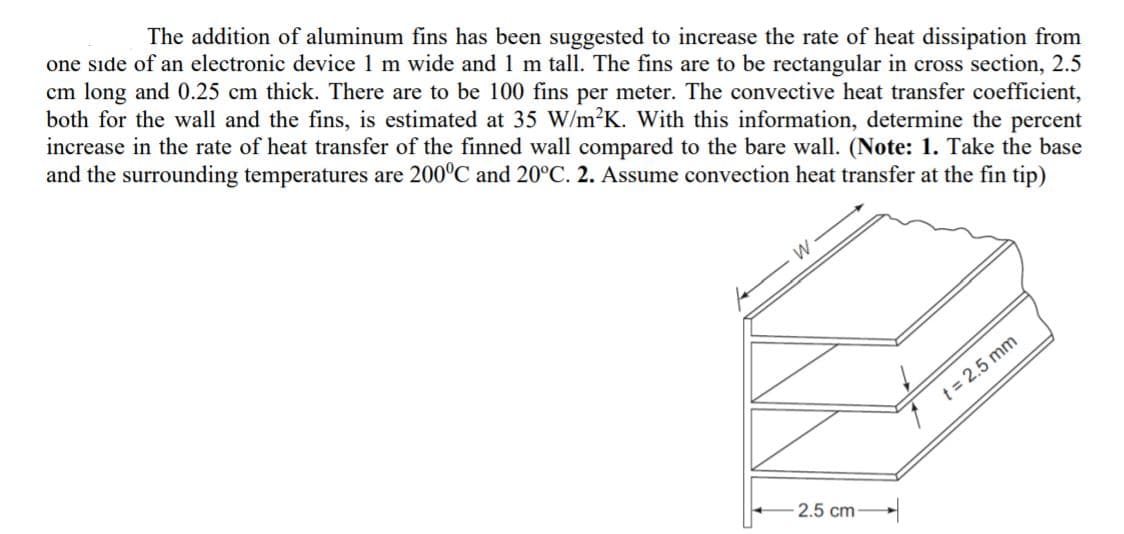The addition of aluminum fins has been suggested to increase the rate of heat dissipation from one sıde of an electronic device 1 m wide and 1 m tall. The fins are to be rectangular in cross section, 2.5 cm long and 0.25 cm thick. There are to be 100 fins per meter. The convective heat transfer coefficient, both for the wall and the fins, is estimated at 35 W/m²K. With this information, determine the percent increase in the rate of heat transfer of the finned wall compared to the bare wall. (Note: 1. Take the base and the surrounding temperatures are 200°C and 20°C. 2. Assume convection heat transfer at the fin tip) 1 t= 2.5 mm 2.5 cm
The addition of aluminum fins has been suggested to increase the rate of heat dissipation from one sıde of an electronic device 1 m wide and 1 m tall. The fins are to be rectangular in cross section, 2.5 cm long and 0.25 cm thick. There are to be 100 fins per meter. The convective heat transfer coefficient, both for the wall and the fins, is estimated at 35 W/m²K. With this information, determine the percent increase in the rate of heat transfer of the finned wall compared to the bare wall. (Note: 1. Take the base and the surrounding temperatures are 200°C and 20°C. 2. Assume convection heat transfer at the fin tip) 1 t= 2.5 mm 2.5 cm
Principles of Heat Transfer (Activate Learning with these NEW titles from Engineering!)
8th Edition
ISBN:9781305387102
Author:Kreith, Frank; Manglik, Raj M.
Publisher:Kreith, Frank; Manglik, Raj M.
Chapter2: Steady Heat Conduction
Section: Chapter Questions
Problem 2.38P:
2.38 The addition of aluminum fins has been suggested to increase the rate of heat dissipation from...
Related questions
Question

Transcribed Image Text:The addition of aluminum fins has been suggested to increase the rate of heat dissipation from
one sıde of an electronic device 1 m wide and1 m tall. The fins are to be rectangular in cross section, 2.5
cm long and 0.25 cm thick. There are to be 100 fins per meter. The convective heat transfer coefficient,
both for the wall and the fins, is estimated at 35 W/m²K. With this information, determine the percent
increase in the rate of heat transfer of the finned wall compared to the bare wall. (Note: 1. Take the base
and the surrounding temperatures are 200°C and 20°C. 2. Assume convection heat transfer at the fin tip)
t = 2.5 mm
2.5 cm-
Expert Solution
This question has been solved!
Explore an expertly crafted, step-by-step solution for a thorough understanding of key concepts.
Step by step
Solved in 3 steps with 5 images

Knowledge Booster
Learn more about
Need a deep-dive on the concept behind this application? Look no further. Learn more about this topic, mechanical-engineering and related others by exploring similar questions and additional content below.Recommended textbooks for you

Principles of Heat Transfer (Activate Learning wi…
Mechanical Engineering
ISBN:
9781305387102
Author:
Kreith, Frank; Manglik, Raj M.
Publisher:
Cengage Learning

Principles of Heat Transfer (Activate Learning wi…
Mechanical Engineering
ISBN:
9781305387102
Author:
Kreith, Frank; Manglik, Raj M.
Publisher:
Cengage Learning